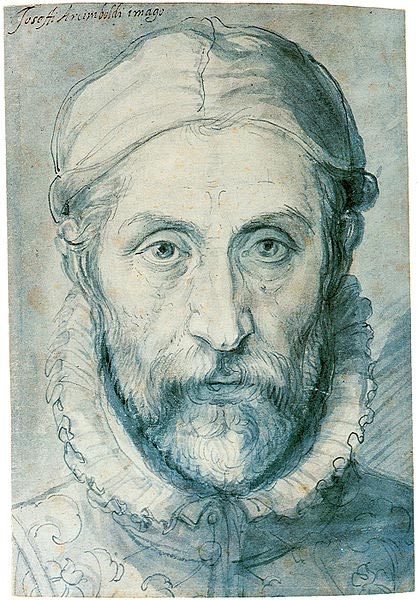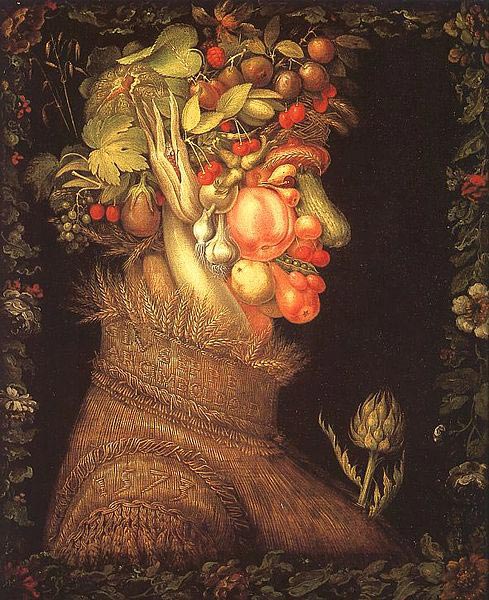| Giuseppe Arcimboldo | |
|---|---|
 |
|
| Born | 1527 Milan |
| Died | July 11, 1593 (age 66) Milan |
| Nationality | Italian |
| Field | Painting |
| Works | View Complete Works The Librarian, 1566 Vertumnus, 1590-1591 Flora, ca. 1591 |
Was he a genius or insane—or a little of both? Some say Italian painter Giuseppe Arcimboldo was 400 years ahead of his time. His stunning surrealist portrait creations using inanimate objects such as fruits, vegetables, fish, books, animals, tree roots and other natural items are still stunning today.
His paintings appear at once to be incredibly modern, yet at the same time, in defiance of any era, trend or categorization.
Many people who encounter his work for the first time assume that Arcimboldo is some artist working today using computer graphics or other cutting-edge techniques to produce bizarre creations – yet his work is more than 400 years old, generated during the High Renaissance.
Famous Teacher, High Position
Arcimboldo was born in Milan in 1527 the son of another artist, Biagio Arcimboldo. Like his father, he started his career designing imagery for stained glass windows. Giuseppe Arcimboldo showed such extraordinary talent that none other than Leonardo da Vinci accepted him as a student.
His remarkable skills won him a highly sought-after position of painting portraits of the most powerful families of his day in Milan. He became the Royal Painter in the courts of Italian emperors Ferdinand I, Maximilian II, and also Rudolf II. He also served the court as a “party planner,” historical records indicate. This meant he helped organize lavish “theme balls.”
But it was portraits the wealthy royal elites most wanted from Arcimboldo – and endless series of them. His patrons were the billionaires of their day, and they were eager to achieve their own sort of immortality by having their images preserved as many times as possible – and seeing themselves through the special creative skills of a genius like Giuseppe Arcimboldo must have been an incredible thrill.
Clever Illusionist
 What’s strange about Arcimboldo’s works is that so many of them are not representational, but rather surrealistic compositions using items from nature, especially foods, such as fruits and vegetables. The items are painted or used as rough analogs of common facial features. For example, a cucumber is used as a nose, apples as cheeks, grapes, cherries, leaves as hair, and so forth.
What’s strange about Arcimboldo’s works is that so many of them are not representational, but rather surrealistic compositions using items from nature, especially foods, such as fruits and vegetables. The items are painted or used as rough analogs of common facial features. For example, a cucumber is used as a nose, apples as cheeks, grapes, cherries, leaves as hair, and so forth.
When looked at from a distance these portraits look human, but as you move in closer, they become less distinguishable as people, and more like a bizarre collections of fruits. Again, Arcimboldo did not limit himself to foods. He created portraits using animal figures, roots and rocks, even books and housewares.
Some of his portraits were clever illusions. A classic example is his famous “Man in the Vegetables.” It looks like a bowl of fruits and vegetables, but when you turn it upside down, the bowl becomes a hat over the face of a man with an onion for a cheek and mushrooms for lips. It’s remarkable.
Controversy
One of Arciboldo’s most famous works is not merely amazing, but was highly controversial in his time. It’s an oil on canvas called The Librarian which features a human being fashioned from books, and other objects associated with books.
It is widely believed that Arcimboldo’s intent was to mock, or make a stinging commentary on the wealthy elite. In his day, only the extremely rich could afford to buy and collect books. But often such people had more money than brains. Many people collected books as status possessions, even though they could barely read or understand the content of the books they owned.
Mannerism Style
Art historians categorize Arcimboldo as a “Mannerist,” which was a style of art that showed relationships between human and natural objects. Mannerism enjoyed popularity between about 1510-20 to around 1590.
It should be noted also that the 16th Century was a period in which educated society was obsessed with puzzles, bizarre imagery, and riddles. This is significant because it belies the idea that Arcimboldo might have been slightly insane or tormented by a deranged mind. Other painters were producing peculiar, surrealist portraits as well, including Leonardo da Vinci himself. These artists were responding to the fads and demands of the day, and to the whims of their wealthy clients.
Works Lost
What’s tragic about the work of Giuseppe Arcimboldo is that the vast bulk of his works are lost. He was certainly not limited to the surrealist Mannerist paintings for which he is famous today. On the other hand, Arcimboldo’s striking images remain more popular than ever, finding their way into a host of modern formats, from the covers of rock albums and books, to influencing films, comics and graphic novels.
Giuseppe Arcimboldo died in Milan, the city of his birth, in 1593. He was 66 years old.